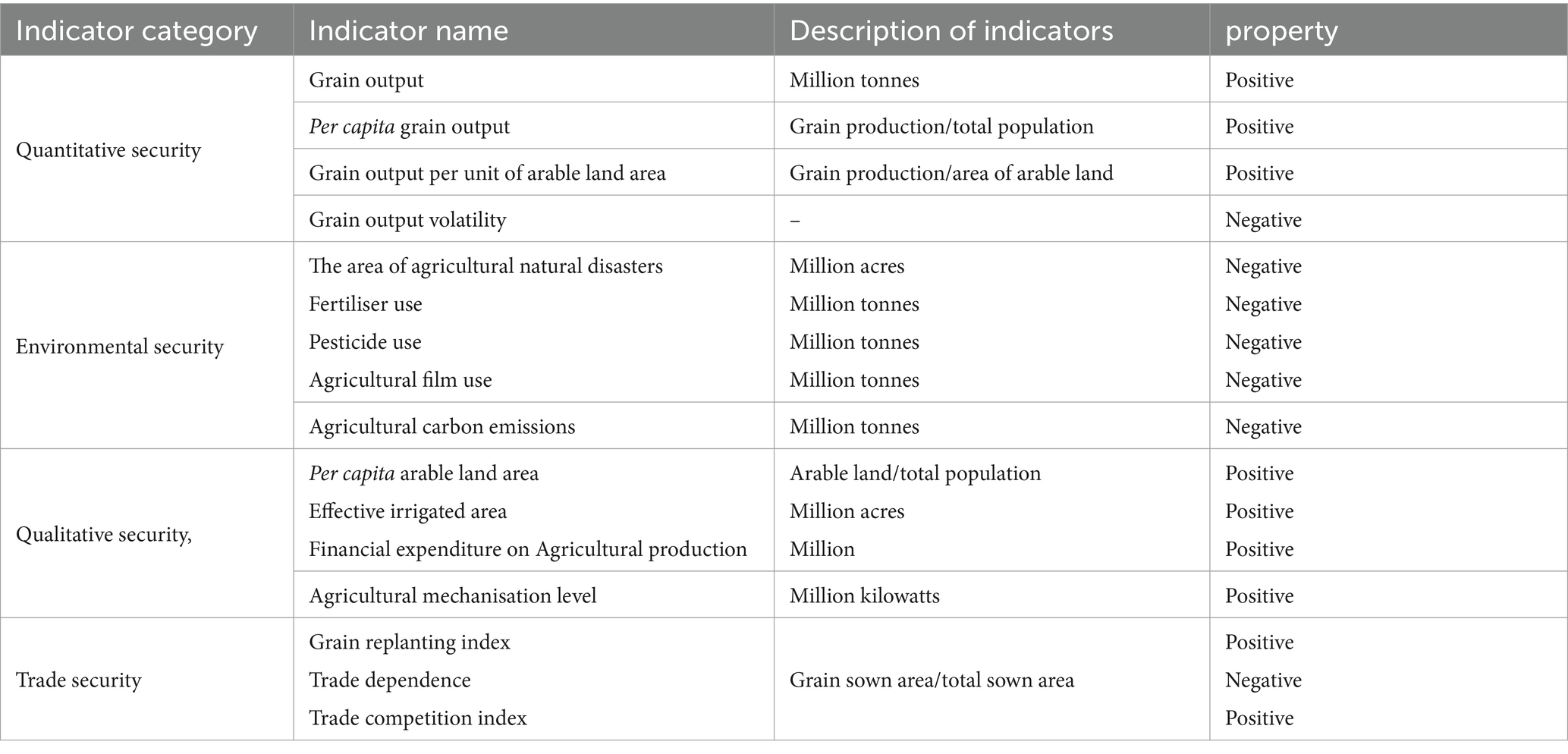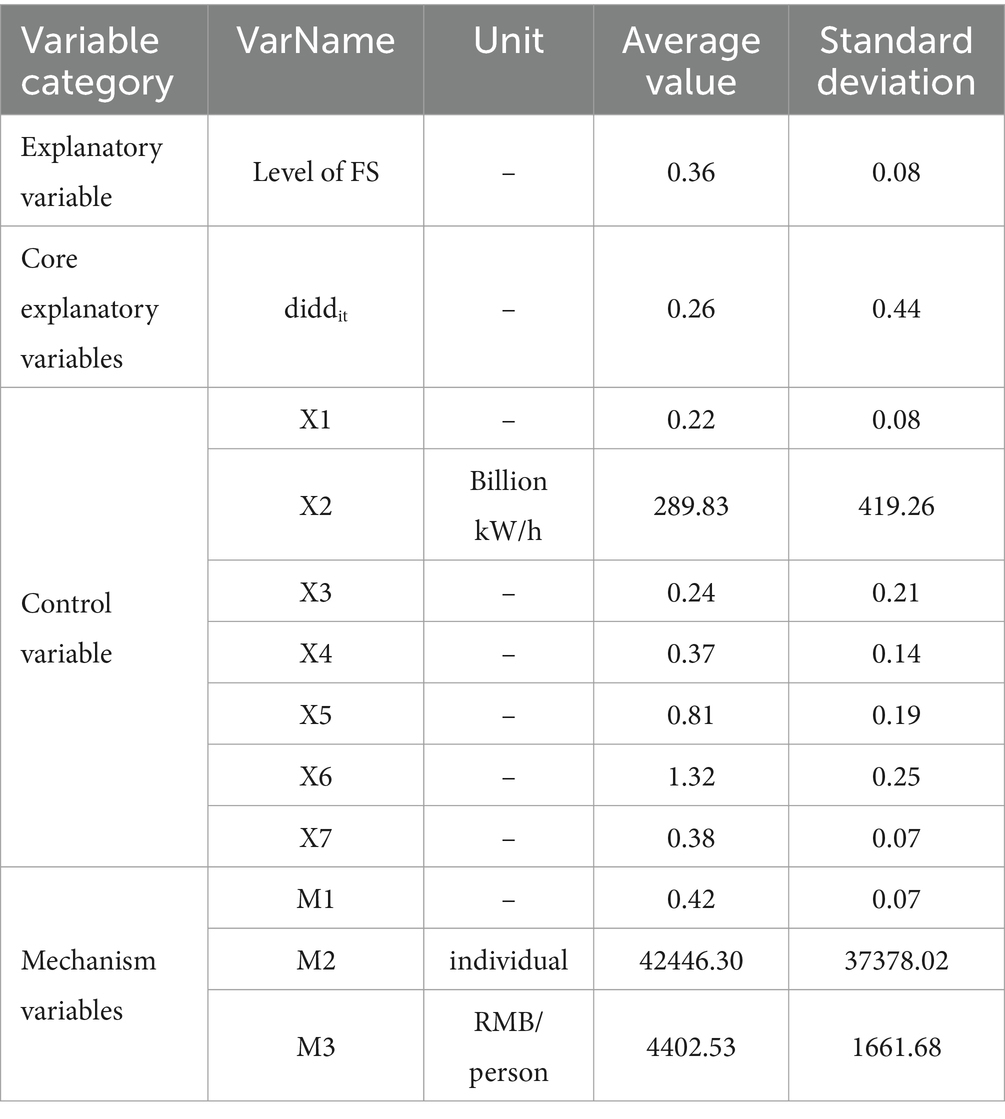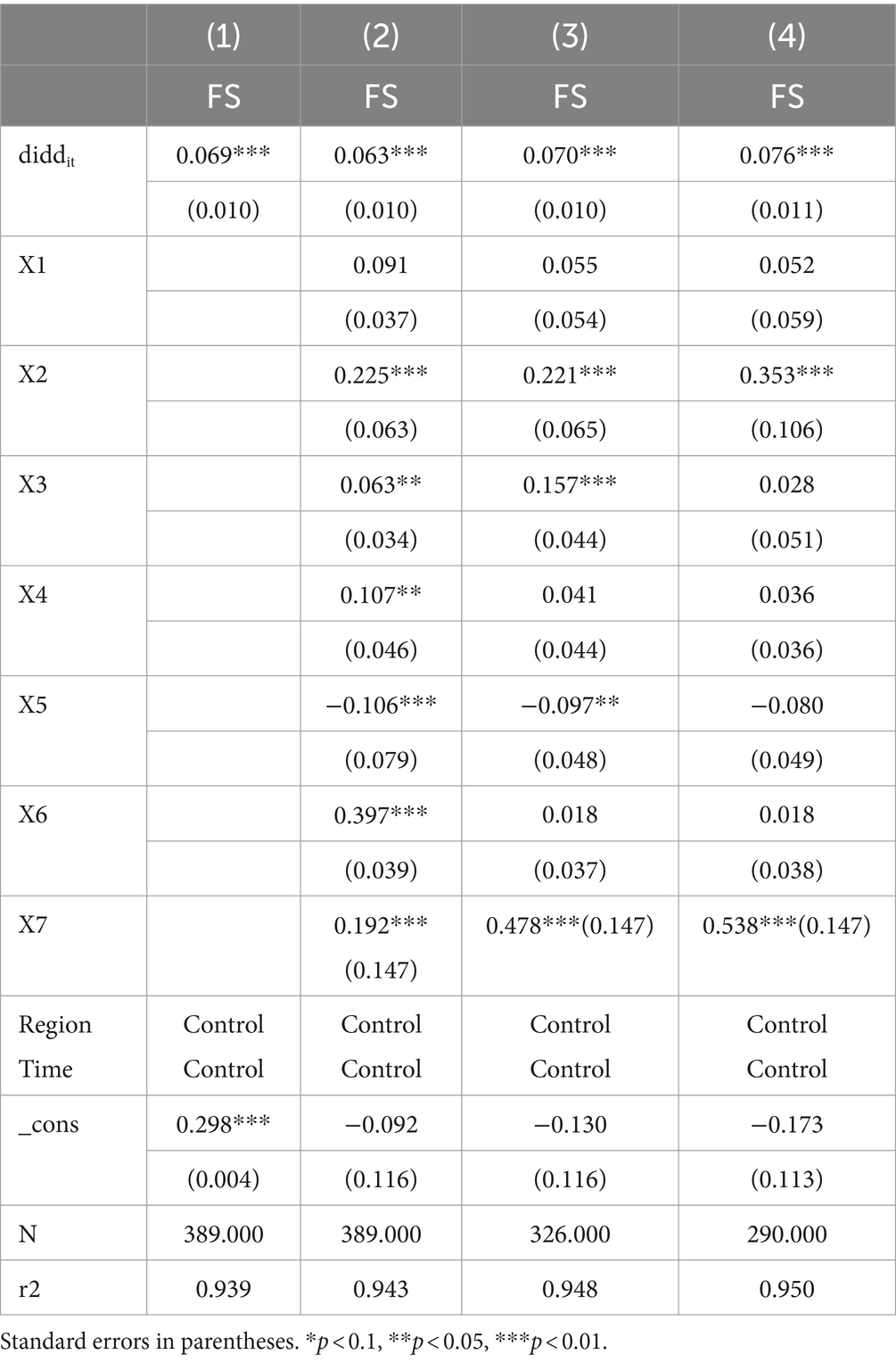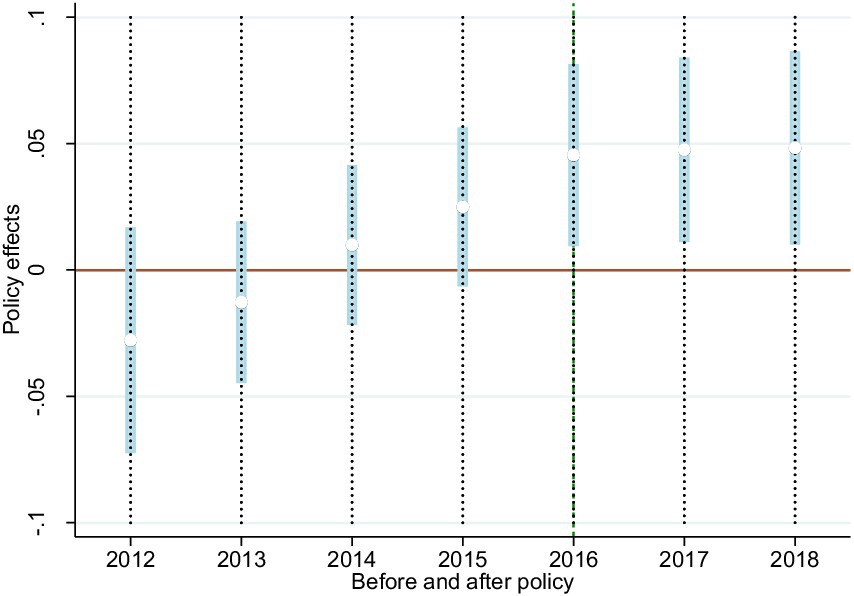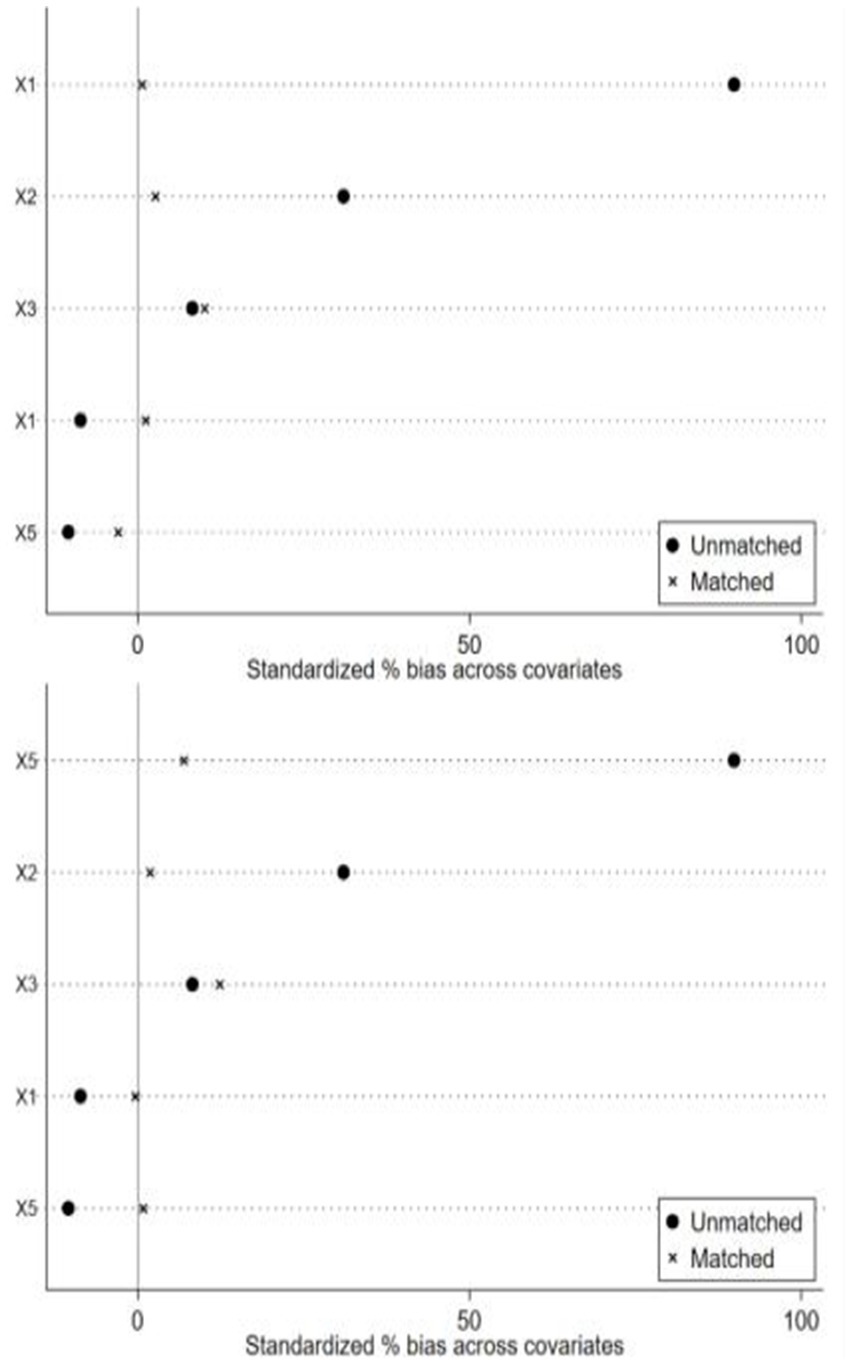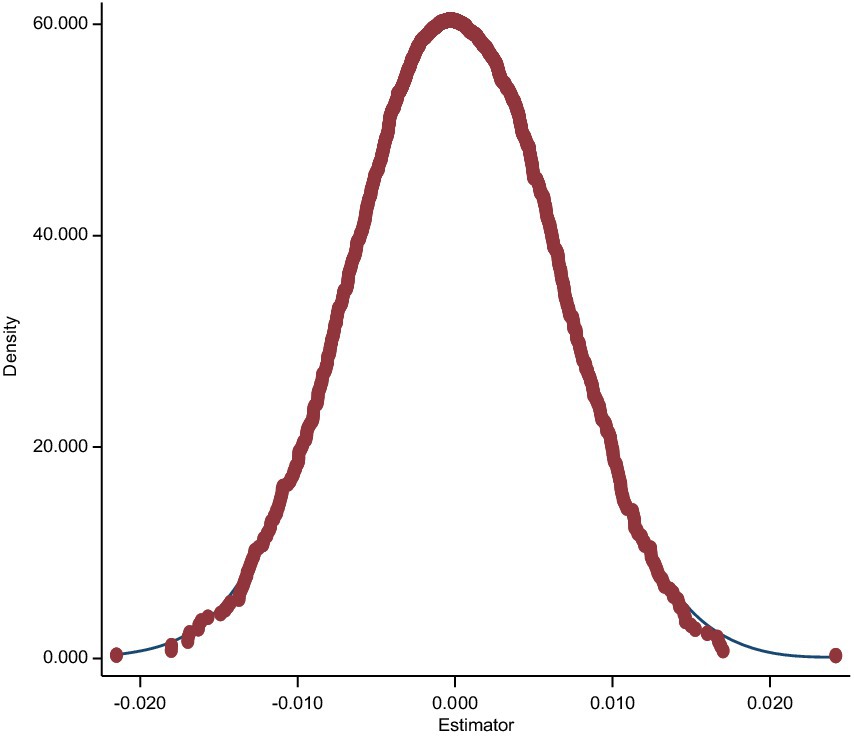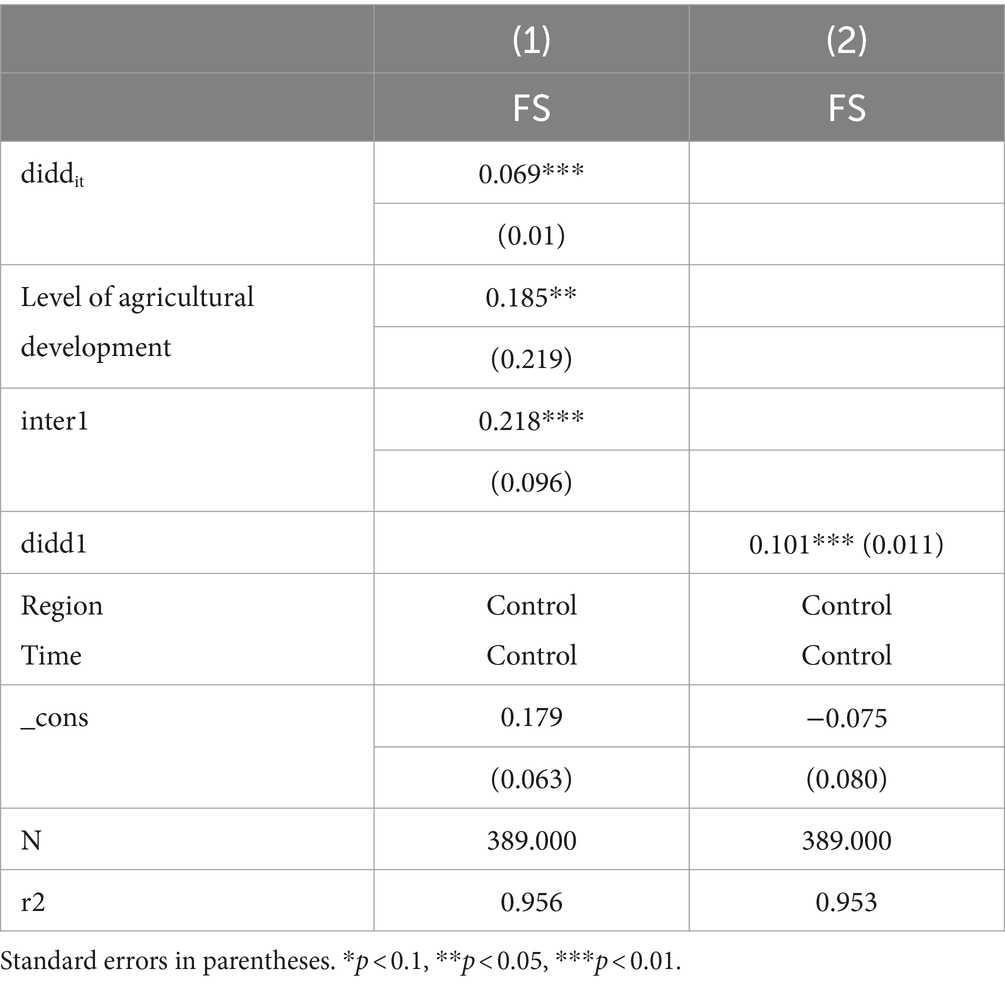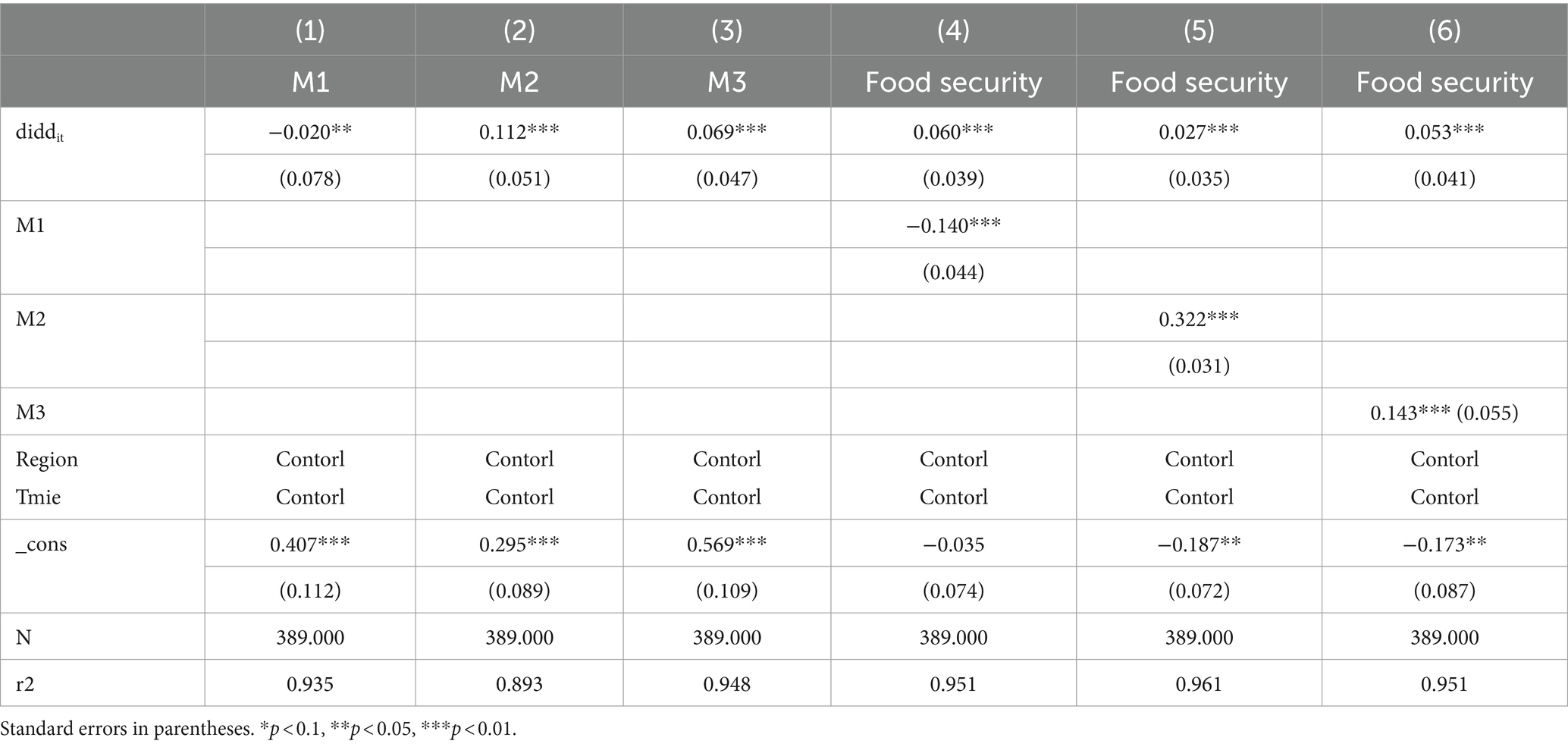- Henan Agricultural University, College of Economics and Management, Zhengzhou, China
Food security (FS) is an important guarantee for world peace and development and the basis for building a community of human destiny, which has a bearing on the sustainable development and future destiny of humankind. This study empirically analysis the relationship between socialisation services in the whole process of agricultural production (ASS) and guaranteeing FS, as well as the path of their role, using provincial panel data from 2010 to 2022 in China as an example, using the double-difference method. The regression results show that ASS can have the ability to contribute to the level of FS, and the conclusion still holds after a series of robustness tests. The results of the heterogeneity analysis show that the role of ASS in guaranteeing FS receives the influence of the level of agricultural development in each region, while it plays a greater role in the main food-producing areas. The mechanism analysis analyses the mechanism of the role of ASS in the whole process of agricultural production in guaranteeing FS from the three links of pre-production, mid-production and post-production respectively, and finds that ASS in the whole process of agricultural production is able to guarantee FS by reducing the cost of purchasing means of production in the pre-production stage, fostering a new type of agricultural management main body in the mid-production stage, and increasing the income of farmers’ household management in the post-production stage. Based on the above findings, this study proposes corresponding policy recommendations. This study can provide insights for ensuring world FS and contribute to maintaining social stability and development. The conclusions of the study are universally applicable, and all countries in the world can benefit from and draw lessons from it.
1 Introduction
‘Food is the God of the people’, agriculture is part of the social, economic, cultural and environmental system and is an important part of the global economy and its driving force (Achterbosch et al., 2014). The gradual shortage of energy in the world, accompanied by an increase in the international price of crude oil (Vochozka et al., 2020a,b), indirectly leads to an increase in the cost of agricultural production. Against this background the costs of crude agriculture are gradually rising, while the output is not able to sustain the national demand. In contrast, the advantages of sustainable agriculture with a higher return on investment are gradually emerging (Pavolova et al., 2021; Akbari et al., 2021). Although the development of sustainable agriculture accompanied by agro-technological innovations, such as the extraction of silica nanoparticles from the pith of coconut shells to improve seed germination (Maroušek et al., 2022), as well as energy innovations, such as the utilisation of renewable energy sources (Bencoova et al., 2021) can be effective in guaranteeing the conduct of the agricultural process, and consequently FS. However, with the continuous growth of the population, the problem of FS can still not be underestimated (Liu and Zhong, 2024). At the same time, due to the differences in the level of development of countries around the world, there are gaps in food production and security capacity. Taking China as an example, in 2020, the world’s average yield level of rice is 4,609 kg/hm2, and China’s average yield level of rice is 7079.59 kg/hm2, which is higher than the world’s average; however, compared with developed countries, such as the United States, which has an average yield level of rice of 8,540 kg/hm2, there is still a large gap in China (Song and Jiang, 2024).
In order to enhance farmers’ motivation in land management, increase the scale of agricultural business, improve agricultural production capacity, reduce dependence on the international food market and guarantee FS, ASS has emerged. As an integral part of modern agriculture, ASS can effectively improve the efficiency of agricultural production and guarantee FS (Kong et al., 2009). On the one hand, ASS connects to the vast number of small farmers on the demand side, and through the services, it links up the scattered small farmers and improves the organisation of small farmers (Gao and Kong, 2013). On the other hand, ASS on the supply side connects diversified agricultural service subjects with higher degree of organisation, which can more economically and efficiently meet the diversified agricultural service demands of dispersed small farmers, and then realise the development drive of small farmers to integrate into modern agriculture (Guo and Wen, 2023). However, despite the development of ASS, there are still deficiencies; therefore, combining the current situation of China’s FS and ASS, it is of great research value to study how to effectively improve the level of FS by relying on the guarantee of ASS.
2 Literature review
FS is a highly complex phenomenon that depends on social, cultural and political systems as well as environmental factors (Arezki and Bruckner, 2011). There is a distinction between FS in a narrow sense, which relates to the output of food crops, and a broader sense, which relates to agriculture as a whole, including fisheries. This study examines FS at the narrow level. Research on FS has focused on food security measurement, connotations, and influencing factors. The connotation of FS is: quantity sufficiency, that is, the sufficiency of food production and supply is the first condition for guaranteeing FS; second is quality safety, people should eat healthy and feel relieved. The third supply structure should be balanced, that is, the food supply should be comprehensive and focus on nutritional matching; finally, sustainable production should be carried out without destroying the ecological balance and wasting resources (Wang and Zhou, 2016). FS has many influencing factors. Some of the studies on the exploration of the factors affecting FS are also related to the measurement of FS. It has been pointed out that the sown area of grain (Chen et al., 2011), fertiliser inputs (Lv et al., 2022), effective irrigation coverage, germplasm resources (Xie and Li, 2021), and the construction of social safety nets (Khan et al., 2023), environmental tax (Samusevych et al., 2021) have a positive impact on FS, and in order to guarantee national FS, a long-term mechanism to promote stable and increased food production that is compatible with the market mechanism should be gradually established and improved (Liu, 2014). In addition, it was found through grey correlation method analysis that the equipping of agricultural machinery was equally important factor affecting FS (Wang et al., 2018). In terms of negative impacts, poor social governance (Khan et al., 2024a), population growth, low levels of agricultural production, and climate change, especially warming, can pose a threat to FS (Khan et al., 2024b).
ASS requires the use of various types of equipment, machinery and other services such as information input, land preparation for harvesting and other basic processes known as services and mechanisms (Manta and Aduba, 2013; Akinbamowo, 2013; Mrema et al., 2014). Existing studies on ASS mainly focus on the role of social services, problems, current situation, countermeasures and other qualitative theoretical analyses. It has been pointed out that ASS can further promote the reduction of chemical fertiliser application by upgrading plot size and promoting off-farm employment of labourers (Zhang M L, et al., 2023); and alleviate the phenomenon of farmers’ land abandonment by alleviating the constraints of technology, labour force, and efficiency (Zeng and Shi, 2022; Yang, 2023). ASS can achieve high-quality development of agriculture by changing production participation, production scale and production mode, and can effectively improve agricultural production efficiency (Tang et al., 2022; Lin et al., 2022) and promote farmers’ income (Yang, 2022). At present, although China’s ASS has made great progress, there are still the following problems: low government management efficiency and lack of targeted policies (Tong, 2016), slow construction speed and low service level (Lin et al., 2016), imbalance in personnel structure and shortage of professionals (Sun et al., 2018), insufficient capacity and imbalance in the supply of services (Sun et al., 2019). Therefore, China’s ASS still needs to make improvements in the management system, service system, talent training, and service capacity (Liu et al., 2022).
In summary, existing research on ASS and FS provides a good theoretical basis for this study and reveals the intrinsic interconnectedness of ASS to ensure FS. However, there are still certain shortcomings in the existing studies. Although it has been pointed out that ASS can effectively improve the eco-efficiency of arable land, the eco-efficiency of arable land as a comprehensive representation of the level of FS is one-sided. In contrast, there is a lack of empirical research evidence on the relationship between ASS and FS, and the mechanism of action that can provide causal identification of the connection. Therefore, this study makes an expansion in the following aspects: analysing the role of ASS in ensuring FS by means of empirical analysis; divide ASS into pre-production, mid-production and post-production segments, and explore the role of ASS in ensuring FS; based on the findings of the empirical analyses, targeted policy advice for FS is provided.
3 Theoretical analysis
In order to better understand the impact of ASS on safeguarding FS, so that scholars from all over the world can clearly sort out the mechanism of action, this study uses theoretical analysis to sort out the path of action of ASS in safeguarding FS. Based on the theoretical analysis, this study proposes corresponding research hypotheses and confirms them later. The ASS provides farmers with the opportunity to obtain better services with lower inputs by integrating the needs of dispersed farmers (Zeng and Shi, 2021), and its services cover the three stages of pre-production, mid-production and post-production. ASS can provide group-buying services in the pre-production period, obtain production materials at lower prices, save production costs, and stimulate farmers’ motivation to increase production to ensure FS (Pang, 2006; Kong et al., 2009). In production, taking the application of agricultural mechanisation as an example, considering the nature of large-scale operations and input costs, more and more smallholders are choosing to outsource agricultural machinery services (Paudel et al., 2019), and for smallholders, the investment in agricultural machinery is a relatively large expenditure, while the sunk costs of machinery are relatively high. As a result, smallholders usually do not have the incentive to purchase their own machinery (Zhou et al., 2020), and in order to manage agricultural production more efficiently, smallholders prefer to outsource the labour-intensive production process to provide technical support services, and the outsourcing of the production process is mainly realised through service organisations such as new agricultural management entities (Belton et al., 2021). Services in the post-production chain are mainly based on processing, storage, transport and marketing. Compared to industrial products, initial agricultural products are of low value and difficult to sell at a good price. Socialised services enhance the added value of agricultural products through deep processing of agricultural products after production, while relying on service organisations to effectively safeguard the sales channels of agricultural products, which effectively promotes the stability and growth of farmers’ income (Li and Cui, 2016). In summary, the following hypotheses were formulated for this study:
H1. ASS can effectively guarantee FS.
H2. ASS can guarantee FS by reducing the cost of purchasing agricultural production materials.
H3. ASS can guarantee FS by fostering new agricultural management entities.
H4. ASS can guarantee FS by increasing farmers’ household income.
4 Research design
4.1 Model construction
This study aims to examine the impact of agricultural socialisation services on FS. The specific idea of this study is to take the pilot of ASS as an entry point and divide 30 regions in China into experimental and control groups. Pilot areas were the experimental group and non-pilot areas were the control group. The impact of agricultural socialisation services on FS is analysed by comparing pilot and non-pilot areas horizontally and adding a time factor to consider a longitudinal comparison of the time series. The specific design is as follows:
4.1.1 Differences in differences model construction
The pilot policy on ASS started in 2016 and the implementation area includes 17 provinces in China. Therefore, this study uses a differences in differences model to analysis the impact of ASS on ensuring FS by comparing the experimental group with the control group.
Where Yit is the level of FS and diddit is the core explanatory variable, which refers to whether or not the ASS policy was implemented in a region in a given year. The core explanatory variables were obtained by multiplying the area dummy with the time dummy, with the area dummy set to 1 for the experimental group and 0 for the control group.
The time dummy variable is set to 0 before 2016 and 1 for 2016 and beyond. The model controls for time and area effects.
4.1.2 Parallel trend test model construction
The prerequisite for the use of the differences in differences model is to pass the parallel trend test, so this study constructs the parallel trend test model as above. In Equation 2, diddit is replaced by Ait, and 2010 is dropped as the base year to avoid multicollinearity.
4.2 Variable selection and data sources
4.2.1 Variable selection
1. Explained variables. According to the previous analysis, the present study is based on the combination of previous studies (Izraelov and Silber, 2019; Li and Wang, 2023; Cui and Nie, 2019). A system of indicators for evaluating the level of FS was constructed from four levels: quantitative security, environmental security, quality security and trade security, and was measured using the entropy method.
Quantitative security includes: grain output, per capita grain output, grain output per unit of arable land area, grain output volatility, and the area of agricultural natural disasters. Grain output volatility is calculated as (Yt-Yt`)/Yt`, with Yt being the grain output in year t and Yt` being the predicted output, which is calculated from the 5-year moving average (Zhang M L, et al., 2023).
Environmental security includes: fertiliser use, pesticide use, agricultural film use, and agricultural carbon emissions. It is important to note that while more effective carbon sequestration technologies have been innovated (Maroušek et al., 2023). Still, the generation of carbon emissions from agriculture cannot be ignored. Agricultural carbon emissions are calculated with reference to Zhu and Huo’s way of calculation (Zhu and Huo, 2022) calculated as shown in Equation 3, Carit is the total amount of carbon emissions, Eit is the total amount of each carbon emission source, and αit is the carbon emission coefficient of each carbon emission source. The table of carbon emission coefficients is shown in Table 1.
Quality security includes: per capita arable land area, effective irrigated area, financial expenditure on agricultural production, agricultural mechanisation level, grain replanting index.
Trade security includes: trade dependence, trade competition index. Trade dependence is measured by the ratio of food imports to total food imports and exports; the trade competition index is calculated as: food exports—food imports / food exports + food imports.
The specific construction method is shown in Table 2.
2. Core explanatory variables. diddit is the core explanatory variable, which refers to whether or not a region has implemented a policy on socialisation services for the whole process of agricultural production in a given year. It is generated as shown above.
3. Control variables. The control variables selected for this study include two categories, one of which is the variables reflecting the state of agricultural and rural development, including the level of labour input in the plantation industry (X1), measured by the ratio of the number of labourers in the plantation industry to the rural population; the level of rural electric power consumption (X2), measured by the total amount of rural electric power consumption; the status of rural outbound workers (X3), measured by the ratio of the number of rural outbound workers to the rural population; the level of land transfer (X4), measured by the ratio of the land transfer area to the total cultivated area; and the status of small farm economy (X5), measured by the number of farm households with an operating scale of less than 10 mu. (X3), measured by the ratio of the number of rural migrant workers to the rural population; the level of land transfer (X4), measured by the ratio of the area of land transferred to the total area of cultivated land; and the status of the small-farm economy (X5), measured by the ratio of the number of farm households with a business size of less than 10 mu to the total number of farm households. The other category responds to regional economic development, including: the level of financial development (X6), measured by the ratio of the balance of deposits in financial institutions to the balance of loans in financial institutions; and the level of domestic trade (X7), measured by the ratio of total domestic retail sales of consumer goods to GDP.
4. Mechanism variables. According to the previous analysis, the mechanism variables selected for this study are: agricultural production costs (M1), measured by the ratio of agricultural intermediate consumption to agricultural GDP; new agricultural business entities (M2), measured by the number of new agricultural business entities; and income from the sale of agricultural products (M3), measured by the average per capita income of farmers’ family business, which refers to the income earned by farmers from the sale of agricultural products.
Descriptive statistics for each variable are shown in Table 3.
5 Analysis of empirical results
5.1 Analysis of regression results
Table 4 presents the regression results computed from Equation 1. Column (1) of Table 4 reports the results of the double difference model without the inclusion of control variables. Column (2) of Table 4 reports the results of the differences in differences model with the inclusion of control variables. In the regression approach, both control for time and region and both use robust standard errors. Based on the regression results, it can be seen that the relationship between the explanatory variables and the core explanatory variables is significantly positive regardless of whether control variables are added or not. This indicates that ASS can significantly guarantee FS. The benchmark regression validates hypothesis H1 of the study.
5.2 Robustness tests
5.2.1 Parallel trend test
The use of the differences in differences model presupposes that the model can pass the parallel trend test. If there is no significant difference between the explanatory variables of the control group and the experimental group before the implementation of the pilot policy of socialised production whole process services, it means that the model has passed the parallel trend test. For ease of understanding, this study uses a graphical presentation of the results of the parallel trend test, as shown in Figure 1. In Figure 1, if the blue line does not intersect with the 0 scale, it means that there is a significant difference between the experimental group and the control group. If they intersect, it means that there is no significant difference. For ease of viewing, the study intercepted parallel trend test plots for 4 years before the policy and 3 years after the policy. Figure 1 shows that before 2016, there is no difference between the experimental and control groups and after 2016, the difference exists. This indicates that the model passes the parallel trend test (Ye et al., 2023). The reason for this is that in 2016 there was no significant difference in the level of FS between pilot and non-pilot areas before the policy was implemented, significant differences in FS levels between pilot and non-pilot areas after policy implementation, therefore it can be judged to have a policy effect and the test passes.
5.2.2 Propensity score matching test
In order to reduce the impact of too much variation between the samples and thus on the regression results, this study examines the regression results by using a combination of propensity score matching with a differences in differences model. In this study, the variables of the control variables that can reflect the status of rural and agricultural development are used as matching variables. For the matching method, nearest neighbour matching (1:4) and kernel density matching were chosen. The matching results are shown in columns (3) and (4) of Table 4. The results show that no matter which matching method is used, the regression results are significantly positive after eliminating the unsuccessful matching variables, which verifies the correctness of the conclusions of this study.
After propensity score matching, the differences between the variables after matching need to be tested, and the deviation of each matching variable after matching should not exceed 10%. The deviation of each matching variable before and after matching is shown in Figure 2. According to Figure 2, it can be seen that the matching results of both matching methods are within the acceptable range, so the propensity score matching results can be used.
5.2.3 Placebo test
In order to avoid bias in the results due to omitted variables and unobservable problems between the experimental and control groups, this study conducted a placebo test on the regression results. Specifically, regression analyses were performed on different sample combinations by disrupting the experimental and control groups, and this process was carried out 1,000 times, and the results of the 1,000 regressions were presented by means of kernel density plots, and the results are shown in Figure 3. Figure 3 shows that the kernel density plot obeys normal distribution and the regression coefficients are all around 0, indicating that the placebo test is passed. Further proof of the correctness of the results.
6 Heterogeneity analysis
6.1 Differences in the level of agricultural development
This section analyse whether differences in the level of agricultural development affect the policy effect of ASS by creating an interaction term. By introducing the interaction term between the moderating variables and the core explanatory variables in Equation 1 is able to analyse the moderating effect, and if the interaction term is significant, it means that the moderating effect exists. The regression results are shown in column (1) of Table 5. The results show that the coefficient of the interaction term is significantly positive, indicating that socialised services in the whole process of agricultural production can have a greater effect in areas with a higher level of agricultural development.
6.2 Heterogeneity analysis of the main food-producing regions
Based on the previous assumptions, this part aims to examine whether ASS in areas belonging to the main food-producing regions would have a more optimal role. The relevant operational methods can be group regression or interaction term regression. Since grouped regressions lead to a reduction in the overall sample size, which could potentially affect the regression results, this study used interaction term regressions. In this study, the areas belonging to the main food-producing regions were set to 1 and the rest to 0. Multiplying this with the time dummy and area dummy in Equation 1 yields the triple difference dummy (didd1). If the triple difference dummy variable is 1, it means that the region is both a major food-producing area and has implemented the ASS policy. If it is 0, then one of the two conditions is not satisfied. The regression results are shown in column (2) of Table 5. The results show that the triple difference dummy variables are significantly positive and the coefficients of the core explanatory variables have increased compared to the original regression equation’s. This suggests that policies for ASS within the main food-producing regions are more effective.
7 Mechanism of action analysis
In this study, a three-step approach was used to analyse the mechanism of action. On the basis of the original regression equation, the mechanism variable m is used to replace the explanatory variables with the core explanatory variables in the regression, and if the result is significant, it indicates that the mechanism of action may exist. On this basis, the mechanism variable is added to the original regression equation, and if the mechanism variable is still significant and the significance of the core explanatory variable decreases or disappears, the mechanism of action exists. Table 6 reports the results of mechanism analysis. The results show that the relationship between each mechanism variable and the core explanatory variables is significant. After adding the original regression equation, the significance of the core explanatory variables decreased and the mechanism variables remained significant. This suggests that ASS can guarantee FS by reducing agricultural production costs before production, strengthening the cultivation of new management subjects during production, and increasing the selling price of agricultural products after production. Mechanistic analysis validated the research hypotheses H2, H3, and H4.
8 Conclusion and policy recommendations
8.1 Conclusion
This study analysis the impact of ASS on safeguarding FS and the mechanism of its action using a differences in differences model. The study found that 1. ASS can effectively guarantee FS. 2. ASS can play a better role in major food-producing areas or areas with a higher level of agricultural development. 3. The mechanism of action found that ASS can guarantee FS by reducing the cost of agricultural production, fostering new agricultural business entities, and increasing farmers’ income. It should be noted that the results of the mechanism of action analysis in this study corroborate the research hypotheses in the theoretical analysis section of this study. These conclusions are derived by means of an empirical study using Chinese provincial panel data for the years 2010-2022. However, from an international perspective, this study can provide valuable insights and lessons learned from China’s experience in promoting ASS for FS in countries around the world.
Compared to existing studies, the present study reached similar conclusions to existing studies in ASS to secure FS. It has been shown that ASS can improve agro-ecological efficiency (Cheng, 2022; Leng, 2023). Compared with existing studies, the contributions of this study are as follows: 1. Existing studies have only analysed the role of ASS from the perspective of eco-efficiency, which does not adequately represent the level of FS. Based on the existing studies, this study incorporates economic and social variables to more comprehensively analyse the impact of ASS on ensuring FS, specifically including per capita arable land area, per capita food yields, food volatility, agricultural natural disasters, government financial expenditure and other factors, which is more comprehensive and scientific compared with the results of existing studies. 2. This study additionally analysis the heterogeneity factors of ASS to ensure FS. 3. This study analysis the mechanism of ASS to ensure FS from the perspectives of pre-production, mid-production and post-production, which have not been found in existing studies, and this study complements and improves the existing studies.
8.2 Policy recommendations
1. National level: Deepening the implementation of ASS. According to the natural, economic and social characteristics of each region, targeted implementation of ASS; focusing on promoting the promotion and implementation of ASS in the main food-producing regions, giving full play to the advantages of equipment, facilities, land and other resources in the main food-producing regions, and effectively guaranteeing FS; strengthening assistance and guidance for regions that are not the main food-producing regions, and providing support in terms of funding, technical personnel and so on; give full play to the role of the main grain-producing areas in driving non-main grain-producing areas in the neighbourhood, so as to make up for the shortcomings of non-main grain-producing area.
2. Regional level: Provinces should continue to implement direct subsidies for grain farmers, specify the target recipients of the subsidies, set reasonable standards, and provide subsidies for the purchase of farmers’ means of production, so as to reduce the costs of purchasing and using means of production; strengthen the cultivation of new types of agricultural business entities such as leading enterprises and cooperatives, and give full play not only to their roles in technical training and production guidance during the process of production, but also to their roles of lowering the costs of purchasing means of production before the process of production and providing integrated services of processing, storage and marketing after production, thus increasing the selling price of grain.
8.3 Future prospects
There is still some scope for improvement in this study. Currently, the use of computers and artificial intelligence (Kliestik et al., 2023; Dvorský et al., 2023), digital technologies (Valaskova et al., 2024; Kliestik et al., 2024) plays an increasingly important role in economic development. In the future we believe that it can play a great role in the field of agricultural development and ensuring FS. In addition, technological innovations in agriculture are constantly taking place, which include not only aspects of grain production and processing, but also production and processing of other crops, for example, innovations in oil extraction technology can effectively increase the supply of oilseeds (Maroušek, 2014; Maroušek et al., 2015). Therefore, in the future, this study will refine the research object. In the choice of explanatory variables, this study is not limited to food crop production, but will take the production security situation of the whole agricultural crop plantation industry as the main object of study; in the choice of core explanatory variables, this study will analyse how to guarantee FS more effectively from the perspective of the combination of artificial intelligence technology, digital technology and ASS.
Data availability statement
Publicly available datasets were analysed in this study. This data can be found at: Data from China Statistical Bureau (https://www.stats.gov.cn/).
Author contributions
YT: Writing – original draft. CZ: Funding acquisition, Writing – review & editing.
Funding
The author(s) declare that financial support was received for the research, authorship, and/or publication of this article. This work is supported by National Social Science Foundation of China (22BJY179); National Social Science Foundation Project Youth Project (23CJY054).
Conflict of interest
The authors declare that the research was conducted in the absence of any commercial or financial relationships that could be construed as a potential conflict of interest.
Publisher’s note
All claims expressed in this article are solely those of the authors and do not necessarily represent those of their affiliated organizations, or those of the publisher, the editors and the reviewers. Any product that may be evaluated in this article, or claim that may be made by its manufacturer, is not guaranteed or endorsed by the publisher.
References
Achterbosch, T. J., Van Berkum, S., Meijerink, G. W., Asbreuk, H., and Oudendag, D. A. (2014). Cash crops and food security: contributions to income, livelihood risk and agricultural innovation. the Netherlands: LEI Wageningen UR: Den Haag.
Akbari, M., Loganathan, N., and Tavakolian, H. (2021). The dynamic effect of micro-structural shocks on private investment behavior. Acta Montan. Slovaca 26, 139–148. doi: 10.46544/AMS.v26i1.01
Akinbamowo, R. O. (2013). A review of government policy on agricultural mechanization in Nigeria. J. Agric. Ext. Rural. Dev. 5, 146–153.
Arezki, M. R., and Bruckner, M. (2011). Food prices and political instability. Washington, DC, USA: International Monetary Fund.
Belton, B., Win, M. T., Zhang, X., and Filipski, M. (2021). The rapid rise of agricultural mechanization in Myanmar. Food Policy 101:102095. doi: 10.1016/j.foodpol.2021.102095
Bencoova, B., Grosos, R., and Gomory, M. (2021). Use of biogas plants on a national and international scale. Acta Montan. Slovaca 26, 139–148. doi: 10.46544/AMS.v26i1.12
Chen, Y., Li, X., and Wang, J. (2011). Changes and effecting factors of grain production in China. Chin. Geogr. Sci. 21, 676–684. doi: 10.1007/s11769-011-0506-9
Cheng, Y. S. (2022). Research on the impact of agricultural socialisation services on green Total factor productivity. Anhui University. doi: 10.26917/d.cnki.ganhu
Cui, M. M., and Nie, C. H. (2019). Research on the evolution of China's food security based on the indicator evaluation system. Proceed. Chinese Academy of Sci. 34, 910–919. doi: 10.16418/j.issn.1000-3045.2019.08.009
Dubey, A., and Lal, R. (2009). Carbon footprint and sustainability of agricultural production systems in Punjab, India, and Ohio, USA. J. Crop Improvement. 23, 332–350. doi: 10.1080/15427520902969906
Dvorský, J., Bednarz, J., and Blajer-Gołębiewska, A. (2023). The impact of corporate reputation and social media engagement on the sustainability of SMEs: perceptions of top managers and the owners. Equilibrium. Q. J. Econ. Econ. Policy 18, 779–811. doi: 10.24136/eq.2023.025
Gao, Q., and Kong, X. Z. (2013). Evolutionary trajectory and policy matching of socialised service system in the whole process of agricultural production in China:1978~2013. Reforms 4, 5–18.
Guo, X. M., and Wen, G. Q. (2023). The development logic, realistic obstacles and optimisation path of socialisation Services in the Whole Process of agricultural production. China's Rural Econ. 7, 21–35. doi: 10.20077/j.cnki.11-1262/f.2023.07.005
Izraelov, M., and Silber, J. (2019). An assessment of the global food security index. Food Secur. 11, 1135–1152. doi: 10.1007/s12571-019-00941-y
Khan, Y., Ashraf, S., and Shah, M. (2024a). Determinants of food security through statistical and fuzzy mathematical synergy. Environ. Dev. Sustain. 26, 14981–14999. doi: 10.1007/s10668-023-03231-y
Khan, Y., Bojnec, Š., Daraz, U., and Zulpiqar, F. (2024b). Exploring the nexus between poor governance and household food security. Econ. Chang. Restruct. 57:92. doi: 10.1007/s10644-024-09679-w
Khan, Y., Daraz, U., and Bojnec, Š. (2023). Enhancing food security and nutrition through social safety nets: a pathway to sustainable development. Sustain. For. 15:14347. doi: 10.3390/su151914347
Kliestik, T., Kral, P., Bugaj, M., and Durana, P. (2024). Generative artificial intelligence of things systems, multisensory immersive extended reality technologies, and algorithmic big data simulation and modelling tools in digital twin industrial metaverse. Equilibrium. Q. J. Econ. Econ. Policy 19, 429–461. doi: 10.24136/eq.3108
Kliestik, T., Nica, E., Durana, P., and Popescu, G. H. (2023). Artificial intelligence-based predictive maintenance, time-sensitive networking, and big data-driven algorithmic decision-making in the economics of industrial internet of things. Oeconomia Copernicana 14, 1097–1138. doi: 10.24136/oc.2023.033
Kong, X. Z., Xu, Z. Y., and Shi, B. Q. (2009). Study on the current situation, problems and countermeasures of the socialised service system in the whole process of agricultural production in China. Jianghan Forum 5, 13–18.
Leng, L. P. (2023). The impact of agricultural socialisation services on green Total factor productivity in agriculture. Jiangxi University of Finance Econ. doi: 10.27175/d.cnki.gjxcu.2023.001859
Li, X., and Cui, C. (2016). Study on the construction of E-commerce brand integration of agricultural products under the environment of "internet+", management science and economics. Atlantis Press, 492–495. doi: 10.2991/icemse-16.2016.124
Li, X. F., and Wang, L. (2023). Evaluation of China's sustainable food security level, spatial and temporal evolution and driving mechanism. Statistics and Decision Making 39, 92–96. doi: 10.13546/j.cnki.tjyjc.2023.19.016
Lin, X. L., Deng, X. S., Luo, D. Q., and Zhu, L. F. (2016). The realistic dilemma and countermeasures of the construction of socialised service system in the whole process of agricultural production in Chongqing. Study on Modernisation of Agricul. 37, 360–366.
Lin, W. J., Su, X. H., Ma, Y., Li, S. M., and Zeng, D. P. (2022). The impact of agricultural machinery socialisation services on the productivity of agricultural land in China - an empirical study based on a three-stage DEA and Tobit model. China Agrochem. News 43, 239–248. doi: 10.13733/j.jcam.issn.2095-5553.2022.11.033
Liu, S. Y. (2014). Analysis of fluctuations in grain production and factors affecting growth in China's main grain-producing areas. Jiangxi Soc. Sci. 34, 96–100.
Liu, Y., Chen, B. P., and He, L. L. (2022). Evolution of socialisation services in the whole process of agricultural production in China, current status of research and prospects. China Agrochem. News 43, 229–236.
Liu, J. J., and Zhong, X. P. (2024). China's food security emergency guarantee mechanism: practice, problems and improvement strategies--taking Henan's heavy rainfall disaster response as an example. Agricultural Econ. Issues. 7, 34–47. doi: 10.13246/j.cnki.iae.2024.07.011
Lv, F., Deng, L., Zhang, Z., Wang, Z., Wu, Q., and Qiao, J. (2022). Multiscale analysis of factors affecting food security in China, 1980–2017. Environ. Sci. Pollut. Res. 29, 6511–6525. doi: 10.1007/s11356-021-16125-1
Manta, I. H., and Aduba, J. J. (2013). Mechanization practice: a tool for agricultural development in Nigeria: a case study of Ifelodun local government area of Kwara state. Int. J. Basic Appl. Sci. 2, 98–106.
Maroušek, J. (2014). Novel technique to enhance the disintegration effect of the pressure waves on oilseeds. Ind. Crop. Prod. 53, 1–5. doi: 10.1016/j.indcrop.2013.11.048
Maroušek, J., Hašková, S., Maroušková, A., Myšková, K., Vaníčková, R., Váchal, J., et al. (2015). Financial and biotechnological assessment of new oil extraction technology. Energy Sources, Part A: Recovery, Utilization, and Environ. Effects 37, 1723–1728. doi: 10.1080/15567036.2015.1048391
Maroušek, J., Maroušková, A., Periakaruppan, R., Gokul, G. M., Anbukumaran, A., Bohatá, A., et al. (2022). Silica nanoparticles from coir pith synthesized by acidic sol-gel method improve germination economics. Polymers 14:266. doi: 10.3390/polym14020266
Maroušek, J., Strunecký, O., and Maroušková, A. (2023). Insect rearing on biowaste represents a competitive advantage for fish farming. Rev. Aquac. 15, 965–975. doi: 10.1111/raq.12772
Mrema, G., Soni, P., and Rolle, R. S. (2014). A regional strategy for sustainable agricultural mechanization: Sustainable mechanization across Agri-food chains in Asia and the Pacific region. Bangkok, Thailand: RAP Publication.
Pang, X. P. (2006). Comparison and analysis of structural differences in the supply and demand of socialised Services in the Whole Process of agricultural production - a survey and reflection based on the current situation of the supply and demand of socialised Services in the Whole Process of agricultural production. Agricultural Technol. Econ. 4, 35–40.
Paudel, G. P., Kc, D., Khanal, N. P., Justice, S. E., and McDonald, A. J. (2019). Smallholder farmers’ willingness to pay for scale-appropriate farm mechanization: evidence from the mid-hills of Nepal. Technol. Soc. 59:101196. doi: 10.1016/j.techsoc.2019.101196
Pavolova, H., Bakalár, T., and Kyšeľa, K. (2021). The analysis of investment into industries based on portfolio managers. Acta Montan. Slovaca 26, 161–170. doi: 10.46544/AMS.v26i1.14
Samusevych, Y. V., Kuzmenko, O. V., and Vysochyna, A. V. (2021). Environmental taxes in ensuring national security. Journal of International Studies: A structural optimization model, vol. 14, 292–312.
Song, H. Y., and Jiang, F. (2024). Food security based on the perspective of stable yield: realistic foundation, main problems and countermeasure suggestions. China Eng. Sci., 1–12.
Sun, D. S., Kong, F. P., and Chen, X. Y. (2019). Experiences, insights and recommendations on the interface between smallholder farmers and modern agriculture. Agricultural Econ. Issues, 46–50. doi: 10.13246/j.cnki.iae.2019.04.006
Sun, S. Y., Sun, Y. D., Hu, R. F., Zhang, C., and Cai, J. Y. (2018). Research on the current situation, problemsand policies of China's agricultural extension system. China Soft Sci. 6, 25–34.
Tang, Y. P., Chen, T., and Yang, J. Y. (2022). The impact of socialisation services on agricultural production efficiency in the whole process of agricultural production in Shandong Province - based on the DEA model. Shandong Agricul. Sci. 54, 159–164. doi: 10.14083/j.issn.1001-4942.2022.02.024
Tong, Z. H. (2016). "De-sectorisation": the key to building a socialised service system for the wholeprocess of agricultural production in China. Exploration and Controversy 6, 60–65.
Valaskova, K., Nagy, M., and Grecu, G. (2024). Digital twin simulation modeling, artificial intelligence-based internet of manufacturing things systems, and virtual machine and cognitive computing algorithms in the industry 4.0-based Slovak labor market. Oeconomia Copernicana 15, 95–143. doi: 10.24136/oc.2814
Vochozka, M., Horák, J., and Krulický, T. (2020a). Predicting future Brent oil price on global markets. Acta Montan. Slovaca 25, 375–392. doi: 10.46544/AMS.v25i3.10
Vochozka, M., Rowland, Z., and Suler, P. (2020b). The influence of the international price of oil on the value of the EUR/USD exchange rate. J. Competitiveness, 12:167–190. doi: 10.7441/joc.2020.02.10
Wang, C. X., Yuan, Y. S., and Zhou, M. H. (2018). Influencing factors of grain yield based on entropy weight grey correlation method. Guizhou Agricultural Sci. 46, 142–145.
Wang, G. M., and Zhou, Q. Y. (2016). An empirical analysis of the factors influencing China's comprehensive grain production capacity. J. Sichuan University (Philosophy and Social Science Edition) 3, 82–88.
Xie, D., and Li, Z. Q. (2021). Study on the co-ordination between rural land-scale management and service-scale management in the context of "three rights division". De Economist, 6:121–128. doi: 10.16158/j.cnki.51-1312/f.2021.06.013
Yang, Z. (2022). A study on the impact of socialisation services in the whole process of agricultural production on the behaviour and performance of farmers' land scale operation : Nanjing Agricultural University.
Yang, X. Z. Q. (2023). A study of the impact of social services in the whole process of agricultural production on the output efficiency of farmland and labour - the case of wheat farmers. Agricul. Develop. Equipment 3, 108–111.
Ye, F., Wang, L., Razzaq, A., Tong, T., Zhang, Q., and Abbas, A. (2023). Policy impacts of high-standard farmland construction on agricultural sustainability: Total factor productivity-based analysis. Landscape 12:283. doi: 10.3390/land12020283
Zeng, F., and Shi, F. (2021). How does agricultural socialized service promote the organic connection between small farmers and modern agriculture: a theoretical analysis framework. J. Jishou Univ. Soc. Sci. 42, 92–100. doi: 10.13438/j.cnki.jdxb.2021.03.011
Zeng, F. S., and Shi, F. (2022). Can socialised services in the whole process of agricultural production inhibit smallholders' cropland abandonment behaviour?--An empirical analysis based on micro-survey data in Xianggan and Zhejiang. Rural Econ. 2, 37–44.
Zhang, X. Y., Bao, J., and Xu, S. W. (2023). Evaluation of food security in China based on entropy weight TOPSIS model. China Agricul. Resources and Zoning 44, 35–44.
Zhang, M. L., Chen, Z. J., Weng, Z. L., and Zhang, Y. H. (2023). Study on the impact of socialisation Services in the Whole Process of agricultural production on the reduction of chemical Fertiliser application - analysis of the regulatory effect based on factor allocation. Agricultural Technol. Econ. 3, 104–123. doi: 10.13246/j.cnki.jae.20220310.001
Zhou, X., Ma, W., Li, G., and Qiu, H. (2020). Farm machinery use and maize yields in China: an analysis accounting for selection bias and heterogeneity. Aust. J. Agric. Resour. Econ. 64, 1282–1307. doi: 10.1111/1467-8489.12395
Keywords: socialisation services in the whole process of agricultural production (ASS), food security (FS), means of agricultural production, new agricultural business entities, farmers’ household income
Citation: Tao Y and Zhao C (2024) The impact of socialisation services in the whole process of agricultural production on food security—quasi-natural experimental evidence from China. Front. Sustain. Food Syst. 8:1418410. doi: 10.3389/fsufs.2024.1418410
Edited by:
Elisa Giampietri, University of Padua, ItalyReviewed by:
Younas Khan, Kohat University of Science and Technology, PakistanStanislav Škapa, Brno University of Technology, Czechia
Copyright © 2024 Tao and Zhao. This is an open-access article distributed under the terms of the Creative Commons Attribution License (CC BY). The use, distribution or reproduction in other forums is permitted, provided the original author(s) and the copyright owner(s) are credited and that the original publication in this journal is cited, in accordance with accepted academic practice. No use, distribution or reproduction is permitted which does not comply with these terms.
*Correspondence: Cuiping Zhao, cGluZ2N1aXpoYW9AMTYzLmNvbQ==
 Ying Tao
Ying Tao Cuiping Zhao
Cuiping Zhao
